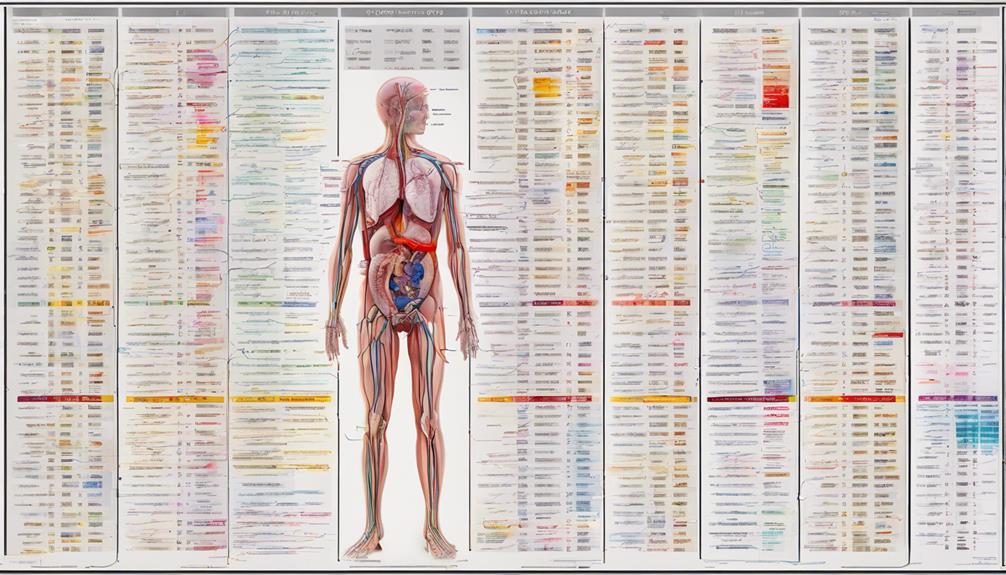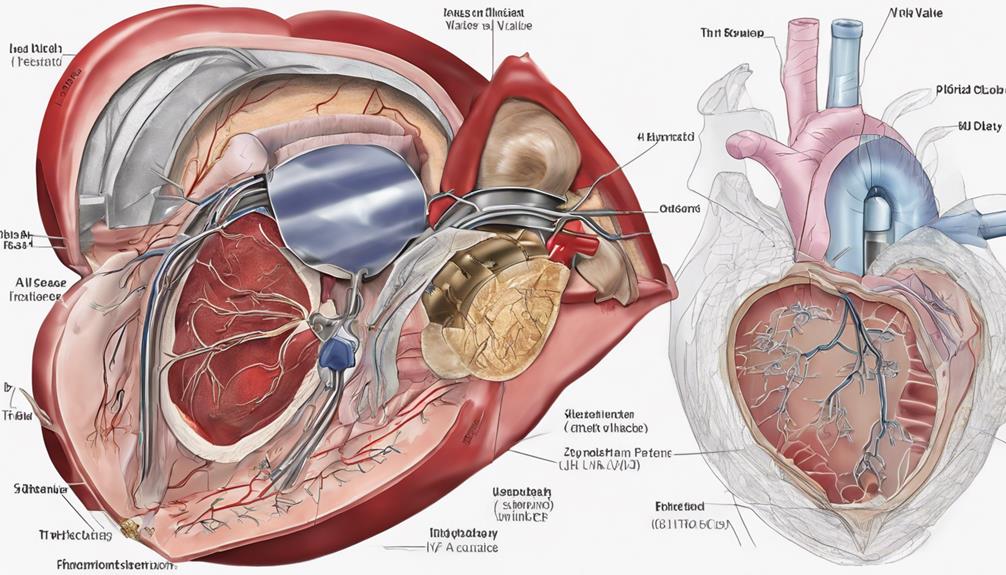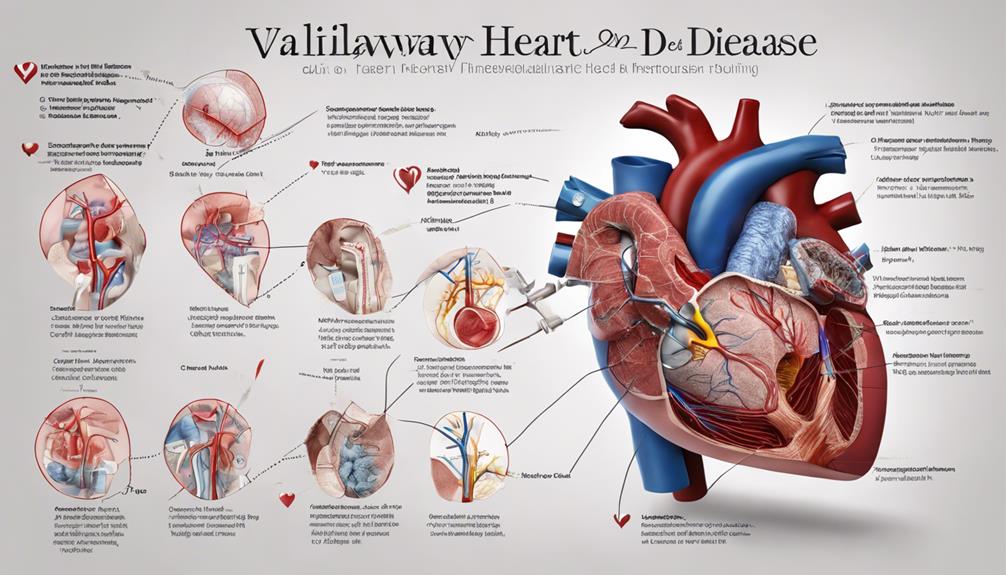Deciphering the intricacies of ICD-10 codes for Valvular Heart Disease is akin to untangling a knotted ball of yarn, where each thread symbolizes a distinct valve disorder that requires comprehension.
The nuances of coding for aortic, mitral, tricuspid, and pulmonary valve conditions can be daunting, but fear not, as we are here to shed light on this intricate web of cardiovascular diagnoses.
Join us as we explore the intricacies of ICD-10 Valvular Heart Disease and demystify the world of cardiac coding and billing.
Key Takeaways
- Accurate ICD-10 coding key for valvular heart disease diagnosis.
- Timely management crucial for symptoms like shortness of breath.
- Surgical intervention may be necessary in severe valvular cases.
- Proper documentation essential for billing and monitoring valvular conditions.
Overview of ICD-10 Codes
In analyzing the ICD-10 codes related to valvular heart disease, a comprehensive understanding of the classification system is essential for accurate diagnosis and coding. The ICD codes, including I05.0, I05.8, I34.0, I35.0, and I35.8, serve as crucial tools for healthcare professionals to precisely document and categorize different types of valvular disorders. These codes enable efficient communication among medical staff and ensure proper billing processes.
Symptoms associated with valvular heart disease, such as shortness of breath, chest pain, and fatigue, underscore the importance of timely diagnosis and management. Valvular conditions can be either congenital or acquired, impacting the functionality of heart valves. In severe cases, surgical intervention may be necessary to repair or replace the affected valve and restore optimal cardiac function.
Healthcare providers rely on accurate ICD coding to track patient outcomes, plan appropriate treatments, and facilitate ongoing care for individuals with valvular heart disease. Understanding the nuances of these ICD codes is fundamental in delivering quality healthcare services to those in need.
Coding for Aortic Valve Disease

Exploring the realm of ICD-10 coding for aortic valve disease unveils a structured approach to accurately document and classify this specific cardiovascular condition. The ICD-10 code for nonrheumatic aortic (valve) stenosis is I35.0.
Aortic valve disease can lead to stenosis or regurgitation, impacting heart function. Diagnosis typically involves an echocardiogram and thorough clinical evaluation to assess the severity and plan appropriate management. Patients with aortic valve disease may present with symptoms such as chest pain and shortness of breath, prompting further investigation and treatment.
Treatment options vary, ranging from medications to surgical interventions, depending on the severity of the condition and individual patient factors. Proper documentation of the specific ICD-10 code for aortic valve stenosis is essential for accurate billing and monitoring of patients with this condition, ensuring they receive the appropriate care tailored to their needs.
Billing for Mitral Valve Disorders
Proper documentation and accurate coding of mitral valve disorders are crucial for precise billing and reimbursement processes in the context of valvular heart disease. When billing for mitral valve disorders, it's essential to use the appropriate ICD-10 codes to ensure proper reimbursement.
Here are key codes to remember:
- Rheumatic mitral stenosis and other rheumatic mitral valve diseases can be billed using ICD-10 codes I05.0 and I05.8.
- Nonrheumatic mitral insufficiency is billable under ICD-10 code I34.0.
- Nonrheumatic aortic stenosis can be billed using ICD-10 code I35.0, while other nonrheumatic aortic valve disorders fall under code I35.8.
Understanding and applying these specific ICD-10 codes for mitral valve disorders will streamline the billing process and help healthcare providers receive accurate reimbursement for the treatment of valvular heart disease.
Accurate documentation and coding play a significant role in ensuring that healthcare services are appropriately reimbursed, benefiting both providers and patients.
Understanding Tricuspid Valve Conditions

Understanding Tricuspid Valve Conditions sheds light on prevalent disorders affecting the tricuspid valve, a crucial component of the heart's function. Tricuspid valve conditions encompass issues like regurgitation and stenosis, which can disrupt the valve's normal function.
Tricuspid regurgitation, the most common disorder, is often linked to right ventricular enlargement, leading to backflow of blood into the right atrium. Symptoms of tricuspid valve conditions, such as fatigue, fluid retention, and abdominal bloating, can significantly impact a patient's quality of life.
Diagnosing these conditions typically involves the use of echocardiography to assess the severity of the valve dysfunction and its effect on heart function. In cases of severe tricuspid valve conditions, surgical interventions like repair or replacement of the affected valve may be necessary to restore proper heart function and prevent further complications.
Understanding and addressing tricuspid valve conditions is vital in ensuring optimal cardiac health and overall well-being.
Documentation for Pulmonary Valve Issues
When documenting pulmonary valve issues, clinicians should include specific details regarding the nature of the stenosis or insufficiency, distinguishing between rheumatic and nonrheumatic origins.
Echocardiography is a valuable tool for diagnosing pulmonary valve conditions, providing insights into the severity and type of dysfunction present.
Treatment options for pulmonary valve issues vary depending on the individual case and may involve medication management, balloon valvuloplasty, or surgical intervention for severe cases.
It's crucial to monitor patients with pulmonary valve problems closely through regular follow-up evaluations to track disease progression and adjust treatment strategies accordingly.
ICD-10 codes I37.0 and I37.2 specifically classify nonrheumatic pulmonary valve stenosis and insufficiency, respectively, aiding in accurate documentation and billing practices.
Frequently Asked Questions
What Is the ICD Code for Valvular Disease?
We've the answer you seek: The ICD code for valvular disease is found in categories encompassing rheumatic mitral stenosis and nonrheumatic aortic stenosis.
Among the billable codes are those for mitral insufficiency and aortic valve disorders. Valvular heart disease can stem from congenital or acquired conditions, impacting heart valve function.
Symptoms like shortness of breath, chest pain, and fatigue often accompany this condition. Diagnosis typically involves a thorough history review, physical examination, and echocardiogram.
What Is a Valvular Heart Disease?
Valvular heart disease involves dysfunction in the heart valves, impacting blood flow within the heart. This condition, whether congenital or acquired, can lead to symptoms like shortness of breath and chest pain.
Diagnosis typically entails a thorough history, physical examination, and imaging tests, such as an echocardiogram.
Treatment options span from medications to surgical interventions, tailored to the severity of the valvular issue.
What Is the ICD-10 Code for Multiple Valvular Heart Disease?
When it comes to multiple valvular heart disease, the ICD-10 code to remember is I08. This code covers a range of rheumatic and unspecified multiple valve disorders, with specific subcategories for different combinations of valve issues.
Accurate coding of I08 is crucial for maintaining precise medical records and devising effective treatment strategies. Utilizing chapter-specific guidelines ensures proper coding and distinguishes these conditions from others.
What Is the ICD-10 Code for Heart Disease?
We dive into the intricate world of ICD-10 codes, unraveling the mysteries of heart disease classification.
The code for heart disease in the ICD-10 system can vary based on the specific diagnosis. Proper documentation and use of these codes are crucial for accurate tracking and communication among healthcare providers.
Mastery of ICD-10 coding empowers us to diagnose, treat, and manage heart conditions effectively.
Conclusion
In conclusion, navigating the realm of ICD-10 codes for valvular heart disease is like deciphering a complex maze of interconnected pathways. Each code serves as a key, unlocking the door to a specific valve disorder and guiding clinicians towards accurate diagnosis and treatment.
By meticulously documenting symptoms and utilizing the appropriate codes, healthcare providers can effectively manage and monitor patients with valvular heart disease, ensuring they receive the care they need to navigate this intricate landscape of cardiac health.








